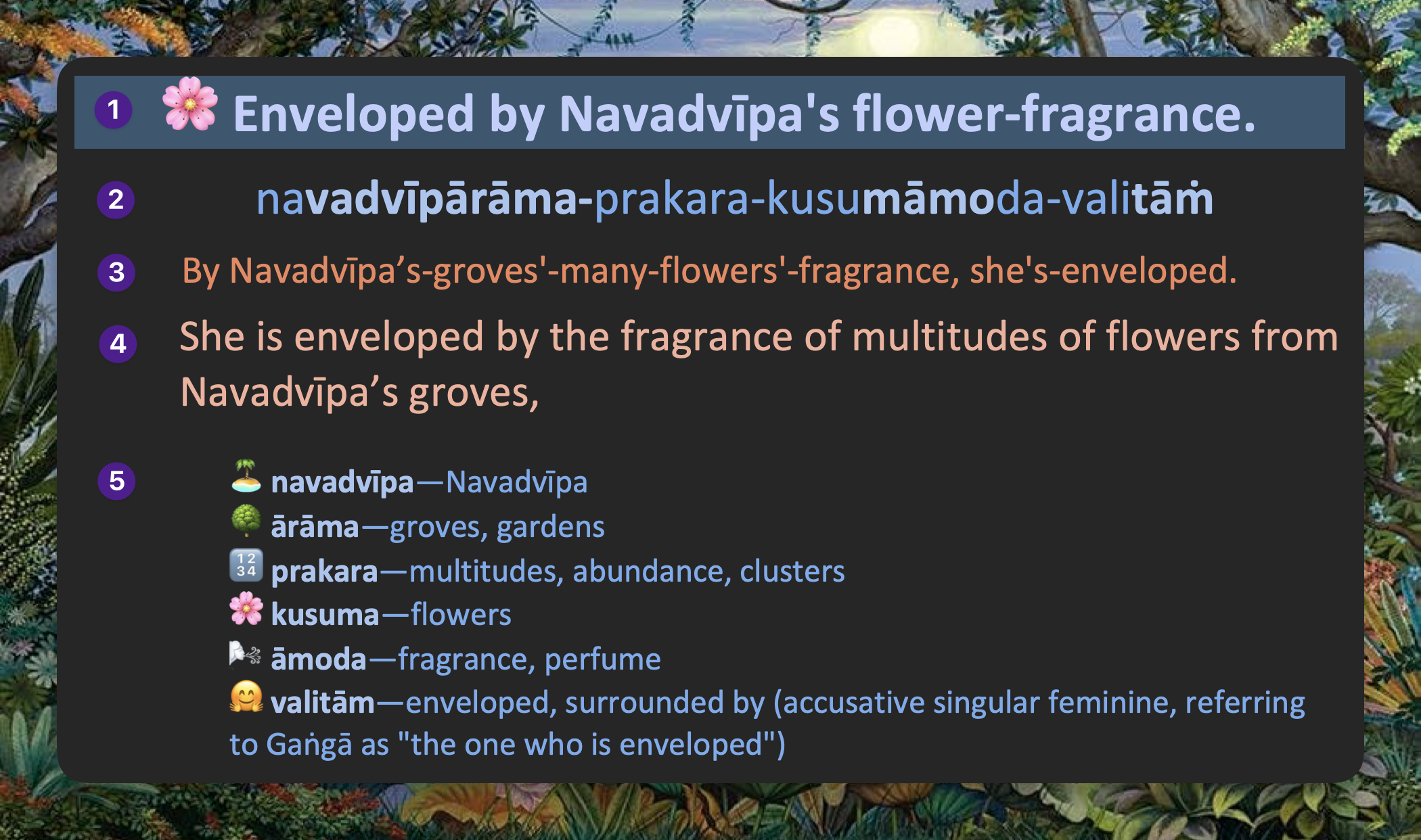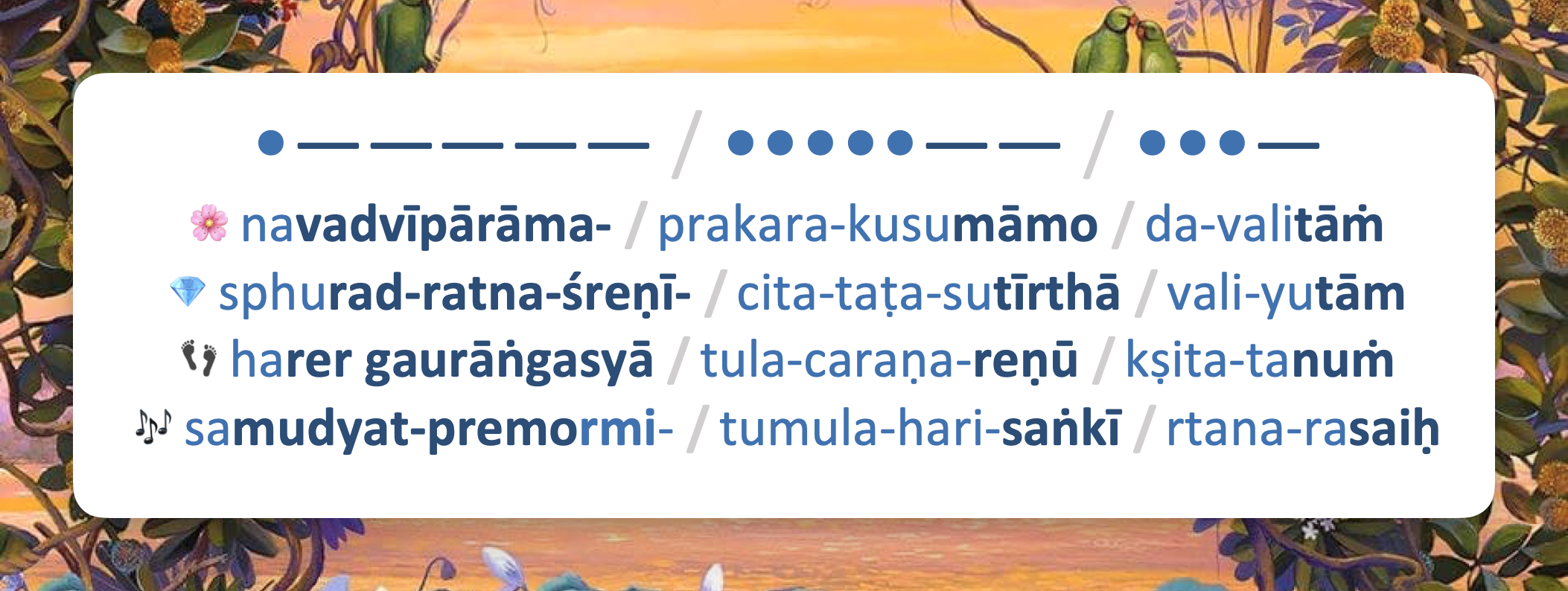On Memorizing Ślokas (Part 3): Making Yourself *Want* to Learn

For most of my life, at least since I was a young teen, I’ve wanted to be someone who journals daily, exercises, memorizes verses, studies śāstra, and on and on. But what I’d end up doing were all the things related to these habits, without spending much time engaging with the habits themselves. I’d get a good quality notebook, start some kind of exercise routine, write down lots of new verses I wanted to memorize, and so on. Lots of times I’d enjoy a brief dance with these habits, and then, inevitably, the honeymoon period would be over. I’d lose enthusiasm after the slightest impediment, and the habit would die.
The problem, I always figured, was that I just didn’t find the right system, or maybe I just didn’t have enough discipline. I’d build lots of elaborate new systems, which would always collapse and reinforce the idea that I just don’t have discipline. My lack of self-confidence would make me escape to watching movies and YouTube videos, listening to music, and so on.
Now, for the first time in my life, in the past couple of years, I’ve somehow managed to overcome this vicious downward cycle with three of the habits I mentioned above: As I write this, I have an unbroken exercise streak of 422 days and a journaling streak of 522. I have read almost every morning since the pandemic lockdowns began in 2020. These are numbers so wildly out of character for me.
The breakthrough didn't come from finally summoning the superhuman discipline I thought I lacked. It came from focusing on finding a way to make myself want to do the thing over and over. I’ve written a few posts here on the different ways I got myself to like journaling and reading.
An example of how I got myself to want to do exercise is that I found an app that was really fun and whose streak-counting function made me greedy to keep the number going up. I gave myself permission to listen to whatever music I wanted while I used it. Sometimes I dangled the reward of a post-workout shake. The goal, in short, was to seduce myself into exercising, rather than leaving it up to my discipline, which would rarely bother to turn up.
Occasionally, discipline still played a role, but only as a last resort to get started when the aforementioned enticements weren't quite enough. After a while, the consistency I’d coaxed myself into created a genuine craving for the effort itself. I had somehow gone from actively avoiding the discomfort of exercise to actively seeking it.
So I’ve gotten to this point with exercising my physical body, and now this brings me to my current, far more stubborn challenge: How can I entice myself to consistently want to exercise my brain, and how can I keep it going long enough so that my brain begins to crave the exertion?
I’m still in the thick of this experiment myself, but I have a feeling I’m onto something. What follows isn’t a perfect, finished system, but it's the game plan I'm working with.
1. Start with Desire, Not Duty
The first rule of making a habit stick is that you have to find some way to enjoy the process, especially in the beginning. For this reason, I recommend only picking verses that you genuinely want to learn—the ones that move your heart or spark your curiosity—not just the ones you feel you should learn. The "shoulds" can come later, after the habit itself has roots.
This reminds me of Gopanandinī Mātājī, a senior Prabhupāda disciple who had lived at the gurukula I went to. She had a program where we would read at a certain time of day, but she didn’t require the books to be devotional. Her thinking was simple: first, get them to fall in love with reading. Once they were used to devouring books, transitioning them to devotional literature would be easy. But without a strong reading appetite, even a devotionally inclined child might have difficulty finishing a long devotional book.
If you’re wondering where to start, I think praṇāma mantras are a great choice. They're generally easier to decipher and you’ll likely recite them more regularly. Bengali verses from Śrī Caitanya-caritāmṛta are also wonderfully short, sweet, and memorable.
2. Become a Detective, Not a Parrot
I probably shouldn’t admit this publicly, but some years ago, I watched an episode from a Sherlock Holmes TV series. Afterward, a funny thing happened. As I sat down to try to understand some difficult Bengali text, I found myself automatically approaching the difficult sentences as a mystery that needed solving. My mind switched into a kind of detective mode, and suddenly, the process felt exciting. (And please, don't take this as my recommendation to watch Sherlock Holmes! 😅 I’m just trying to illustrate the helpful mindset to get into.)
This shift is crucial, because nothing kills motivation faster than forcing yourself to memorize a string of foreign words you don’t understand. It’s boring, and even if you succeed, the words won't stick because there’s no intelligible idea behind the words for your mind to hold onto. Besides, what’s the point of remembering a jumble of syllables that have no meaning to you?
I discovered a neat trick last night that made understanding the words in the Gaṅgā-devī praṇāma-mantra easier, and even a little fun. I created a special prompt to use with an AI tool like ChatGPT, Claude, or Gemini. I paste in the verse, translation, and the prompt, and it gives me an incredible resource for dissecting it.
Here’s an example of what it produced for one line of the Gaṅgā verse memorization program we had yesterday:

- An emoji and title representing the line: This gives me a quick visual hook that’s very helpful for recalling the sequence of lines later on.
- The Sanskrit line: Ready for memorizing.
- A super-simple translation following the Sanskrit word order: This is key for understanding the raw meaning of each Sanskrit word in order and getting a gist of the whole line.
- A natural English translation: How we’d actually say it if we were explaining the meaning to someone.
- A word-for-word breakdown with more emojis: This makes the meaning of each Sanskrit word clear, and the emojis make it a little playful and memorable.
Here is the prompt if you’d like to try it:
This isn’t about letting the AI think for you. One of my favorite ways to use these tools is to get them to help me think and engage more deeply. It took me less than a minute to paste in the prompt and verse with the translation, and then it generated this fantastic resource. Doing it on my own would have taken ages.
Bonus Tip on Meter: As you know, Sanskrit verses have precise meters. Below are two websites that are super helpful for finding out the meter of any Sanskrit verse. Just paste in the verse, and they’ll show you the meter and even bold the long syllables to help you find the rhythm:

(The second site will even show you a video of a person reciting a verse in the same meter.)
By the way, if you ever get stuck on the meter of a verse you’re trying to learn, feel free to send it to me on WhatsApp (+91 7895939316). I’m happy to recite it for you in a voice message. It’s a lot easier to remember a verse when you recite it in the proper meter.
3. Don't Go It Alone
This step, for me, is one of the most effective and satisfying of all. I’ve noticed that anything that remains only in my head tends to vanish into the ether. But if I bring it out into tangible words—spoken or written—it feels more real, especially when I have to express it to another person. I also have a much stronger desire to truly understand what everything means if I know I have to explain it to someone else. The best way to learn is to teach.
I recently tried teaching a few verses we came across in our morning Śikṣāṣṭaka readings, and I was surprised how effortlessly I memorized them. You don’t even need to fully comprehend everything. Just sharing what you do understand of the most important words is enough.
Here’s an idea: find a friend who also wants to learn. Decide on verses together and take turns teaching them each other. You teach your friend verse A, your friend teaches you verse B, you teach verse C, and so on. You lift half the burden of study from each other, and you gain the immense motivational power of accountability. I’m personally A LOT more likely to follow through if I’m doing something with someone else. That's why occasionally teaching verses at the end of our daily online readings is the strategy I'm counting on to finally make this verse memorization habit stick.
4. Create a Simple Ritual for Revision
Memorizing a verse is only half the battle; the other half is revision. I’ve found the ideal time for this is early in the morning, before or after Maṅgala-ārati, when my mind is calm, fresh, and in that "alpha state." I go for a morning walk and either recite the verses out loud or just turn them over in my mind. The key is to have a trusted, scheduled time where revision happens automatically. There’s much more to say on revision, but for now, just build that simple morning ritual.
5. Close the Loop with a Reward
While having a new verse in your mind is a reward in itself, sometimes rewarding yourself in other ways makes you want to continue on memorizing more. I have fond memories from gurukula of when Nanda Kishor bought us all candy bars for memorizing a chapter of Gauḍīya-kaṇṭhahārā.
This principle is beautifully echoed in a sweet anecdote our Śrīla Gurudeva shared about his dear godbrother:
Pūjyapāda Vāmana Mahārāja’s childhood name was Santoṣa. ... Guru Mahārāja taught him everything. He would give Santoṣa a ‘lemon juice’ (candy) for every verse he memorized, so he would memorize up to a dozen verses or more a day. (Excerpt from A True Servant, A True Master)
The reward doesn’t have to be big. You can be creative and come up with something fun with your śloka-learning buddy. Or perhaps the reward can be of a different nature entirely, like reciting the verse for a Vaiṣṇava you deeply admire. I'm sure they would be delighted to hear it and offer their encouragement.
Ultimately, the goal is to transform this practice from a chore we are supposed to do into something we want to do. I hope some of these ideas help you on that journey.
Now, I’d love to hear from you. Let me know if any other techniques have worked for you that I didn’t mention—I’m always eager to try new things!
• Focus on Meaning, Not Just the Sequence of Words
• Gaining Focus as a Secondary Benefit



Comments ()